February 2004
Flying Mole
Corporation DAD-M100pro HT Mono Amplifiers: Measurements
All amplifier measurements are performed
independently by BHK Labs. Please click to learn
more about how we test amplifiers there. All measurement data and graphical
information displayed below are the property of SoundStage! and Schneider
Publishing Inc. Reproduction in any format is not permitted.
- Measurements were made with 120V AC line voltage.
- Power output and distortion plotted with one channel driven
(this is a mono amplifier).
- Gain: 25.6x, 28.2dB.
- Output noise, 8-ohm load, 1k-ohm input termination: wideband
205mV, -22.8dBW; A weighted 0.26mV, -80.7dBW.
- AC line current draw at idle: 160mA.
- Output impedance at 50Hz: 0.08 ohms.
- This amplifier does not invert polarity.
Power output with 1kHz test signal
- 8-ohm load at 1% THD: 103W
- 4-ohm load at 1% THD: 153W
General
The Flying Mole DAD-M100pro HT is an interesting
switching-amp design utilizing an AC line-level switching power supply. This eliminates
the usual 60Hz power transformer and, hence, accounts for its light weight.
Chart 1 shows the frequency response of the amp with
varying loads. As can be seen, the output impedance, as judged by the closeness of spacing
between the curves of open circuit, 8-ohm, and 4-ohm loading is very low up to several
kilohertz, beyond which the effect of the output low-pass filter comes into play. The
effect of this would be that the last two octaves of the audio range might have as much
variation with a real speaker load of up to +/-1dB depending on the particular
speaker’s impedance characteristic. The variation with the NHT dummy speaker load is
about +/- 0.5dB over the audio range. The literature for this amp design suggests that
there is some "virtual damping" in the output low-pass filter, but the chart
suggests otherwise. Chart 2 illustrates how total harmonic distortion plus noise versus
power varies for 1kHz and SMPTE IM test signals and amplifier output load. As can be seen,
attainable power is greater for the 4-ohm load, as is usual for most power amplifiers.
Total harmonic distortion plus noise as a function of frequency at several different power
levels is plotted in Chart 3. Amount of rise in distortion at high frequencies is
relatively low -- a desirable characteristic. Damping factor versus frequency is shown in
Chart 4. A spectrum of the harmonic distortion and noise residue is plotted in Chart 5.
The overall noise floor of this plot is somewhat higher than most linear solid-state
amplifiers due to the effect of the switching noise in the output.
| Chart 1
- Frequency Response of Output Voltage as a Function of Output Loading |
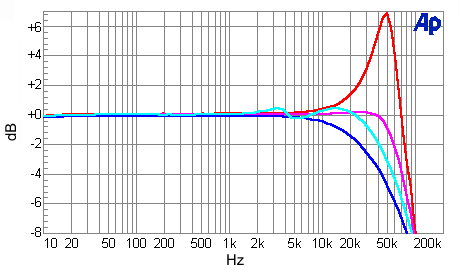
Red line: open circuit
Cyan line: NHT dummy-speaker load
Magenta line: 8-ohm load
Blue line: 4-ohm load
| Chart 2 - Distortion as a Function
of Power Output and Output Loading |
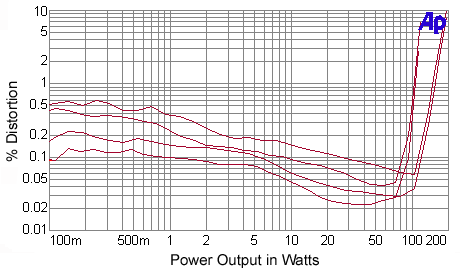
(line up at 10W to determine lines)
Top line: 4-ohm SMPTE IM
Second line: 8-ohm SMPTE IM
Third line: 4-ohm THD+N
Bottom line: 8-ohm THD+N
| Chart 3 - Distortion
as a Function of Power Output and Frequency |
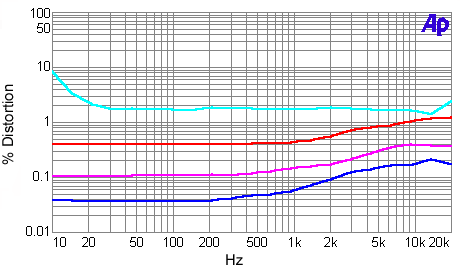
4-ohm output loading
Cyan line: 160W
Red line: 70W
Magenta line: 20W
Blue line: 2W
| Chart 4 - Damping Factor
as a Function of Frequency |
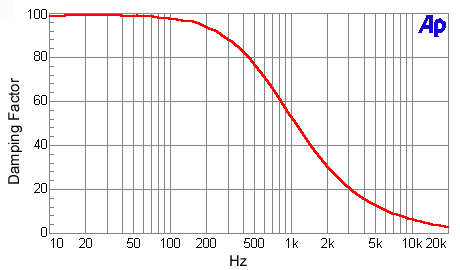
Damping factor = output impedance divided into 8
| Chart 5 - Distortion and
Noise Spectrum |
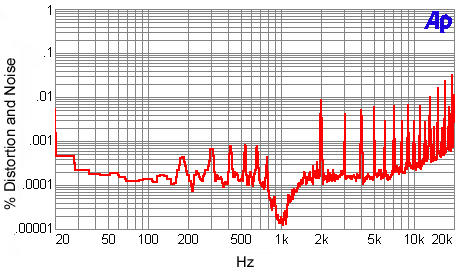
1kHz signal at 10W into a 4-ohm load
|
![[SoundStage!]](../titles/sslogo3.gif) Home Audio
Home Audio ![[SoundStage!]](../titles/sslogo3.gif) All Contents
All Contents



